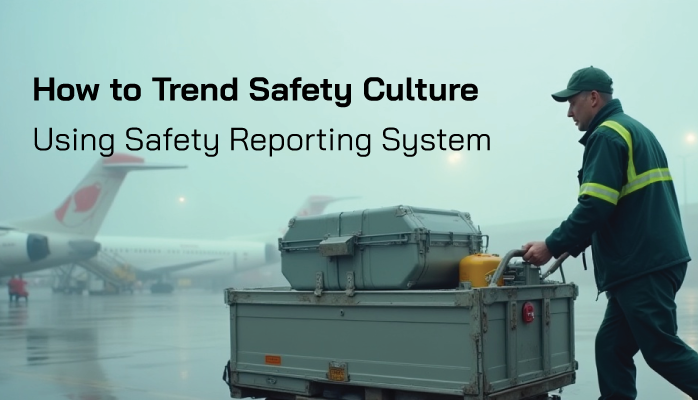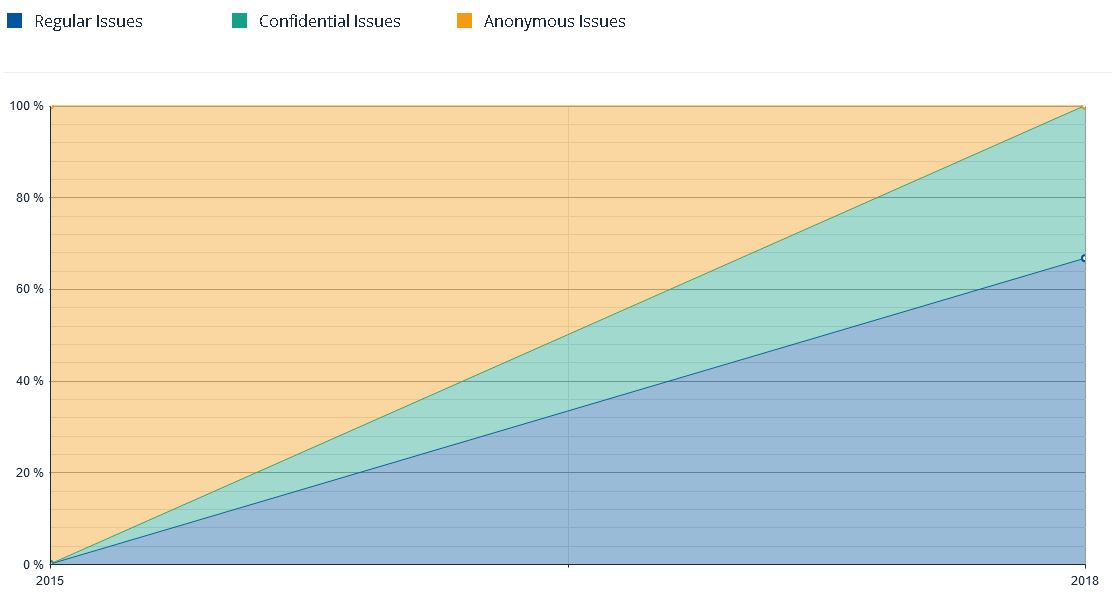Aviation SMS Success Dependent on Safety Culture

Whether safety professionals or upper management like it or not, a successful aviation safety management system (SMS) is dependent on safety culture. This fact holds true for every aviation industry segment, including:
- airlines;
- airports;
- maintenance organizations, etc.
Your company can have the best risk management processes and the most expensive aviation SMS database, but when your safety culture does not support the organization's SMS initiative, your company will never realize the full benefits of an aviation SMS. Furthermore, risk is not being managed properly.
Does this bear repeating? Unless you have a positive, trusting safety culture, you will be wasting a significant portion of your SMS investment. Money will be left lying on the table and management will miss out on the promised benefits of the aviation SMS.
With this in mind, how do you know whether your safety culture is either improving or in a slowly imperceptible decline?
Related Safety Culture Articles
- What Is Safety Culture in the Aviation Industry?
- 5 Characteristics of Effective Aviation Safety Cultures
- 6 Types of Safety Culture in Aviation Safety Management Systems
Importance of Safety Culture to Aviation SMS
Why is safety culture so important to aviation SMS implementations? Every aviation SMS requires safety data to fuel the SMS' risk management processes in order to:
- Treat identified safety concerns;
- Manage hazards to avoid risk consequences and recurrence of unwanted events;
- Identify sub-optimal processes and procedures; and
- Take advantage of opportunities to continuously improve operations.
Inputs into the aviation SMS' risk management process will come predominantly from two sources:
- Reported safety issues; and
- Audit findings.
Without inputs into your SMS risk management machine, you basically have a paper SMS that is about as effective as having an aircraft to earn revenue, but no marketing machine to attract passengers.
Safety Reporting Culture Reflects Organizational Safety Culture
When a healthy safety culture fully adopts SMS principles, this will become evident in the organization's safety reporting metrics. Healthy safety reporting activity reflects an organization that:
- Understands the purpose of the aviation SMS;
- Has fully integrated aviation SMS principles into daily organizational activities;
- Realizes that the SMS is to improve safety and not to weed out under-performing employees;
- Embraces just culture and affords employees protection from management for self-reporting errors and mistakes.
Visible indications of a healthy safety reporting culture have been described as having a monthly rate of one reported safety issue for every ten employees. I've also seen another metric that is based on an annual calculation. This annually tallied metric calls for one reported safety issue for every employee during the course of a year. For example, if your company has 200 employees, you can expect 200 safety reports for the year or 16-17 safety reports per month.
Related Safety Reporting Culture Articles
- 5 Simple Tips to Improve Aviation Safety Reporting Cultures
- How to Write Non-Punitive Reporting Policy for Aviation SMS
- How to Develop Healthy Safety Reporting Cultures in Aviation SMS
Most Companies Struggle With Safety Culture
Companies with wildly successful safety cultures are rare. Most operators have trouble with healthy safety reporting activity. The most common reasons for poor safety reporting metrics are:
- Lack of management trust (fear of retribution);
- Employees don't know what types of issues to report (hazard identification);
- Supervisors dissuading employees from reporting safety issues for various reasons;
- Apathy (employees show up to work for just the paycheck);
- Poor tools to report safety concerns (paper reports, cumbersome safety reporting system);
- Lack of transparency after employees submit safety reports;
- No visible action resulting from employees submitting safety reports; and
- Lack of positive feedback to a reporter which promotes repeat behavior.
You may have noticed that I included "supervisors dissuading employees from reporting safety issues." Yes, this does happen. I've seen cases where supervisors did not want undue attention drawn to their area of operations; therefore, they would tell employees to "informally" report, and allow the "department to work it out."
Other cases I've seen where supervisors tell employees "not to report safety issues" is when the supervisor believes the safety investigation process is too overwhelming and creates too much extra work for the managers. This may be a justified concern. We have seen a few companies become slaves to their complex risk management processes. When your SMS risk management processes are not easy to execute on a repeatable basis, then you have big problems.
When your aviation SMS' processes become too complex and difficult to manage, your safety culture will suffer.
Safety Reporting Data Useful for Trending Safety Culture

Every aviation service provider that we have worked with has adopted a "non-punitive reporting policy." A non-punitive reporting policy affords employees protection from management for self-reporting safety issues, such as errors and mistakes. Some circumstances are not protected by a non-punitive reporting policy, such as when employees:
- purposefully or maliciously sabotage equipment;
- engage in unlawful acts;
- are under effects of unlawful drugs or alcohol; or
- are woefully negligent and deemed an unacceptable risk to safe operations.
The non-punitive reporting policy is important to every aviation SMS because employees will NOT report safety issues unless they are afforded these protections from managerial retribution. This becomes evident in certain Asian cultures where management's first response is to fire or punish an employee for reporting an honest mistake. "Heads must roll!" is the first response management will take to assure stakeholders that the "problem has been dealt with." In these cases, employees will do everything in their power to avoid the investigation. Hence, the safety reporting activity in most Asian cultures is below that witnessed in Western cultures where employees see:
- the non-punitive reporting policy; and
- management abiding by the non-punitive reporting policy.
In order to trend safety culture using your SMS' safety reporting activity, you will need data... lots of data, if you can get it. This data will be "safety reports," of course. However, we need more than safety reports.
In order to trend safety data, we need sufficient data that spans multiple time periods, whether you are measuring in months or years. Several years' worth of safety reports is best. The more safety reports we have to create trending charts, the more reliance we can place on our analysis, and management will also view the trending charts as "more credible" if they have more than two years upon which to base their assumptions.
Related Articles on Creating Aviation SMS Trending Charts
- Aviation Safety Managers' Best Friend - Trending Charts
- How to Use Trending Charts in Aviation SMS
- Six Steps How to Perform Trend Analysis in Aviation SMS
Not All Safety Reports Are Created Equal
The non-punitive reporting policy is designed to engender trust between line employees and management. Non-punitive reporting policies not only build trust but increase the chances that employees will report safety concerns. Without some protection from management, I wouldn't bother to report unless absolutely necessary, so why would anyone else?
So let's say that employees are reporting safety concerns through your aviation SMS safety reporting system. Most operators' safety reporting systems maintain various levels of identity protection when reporting safety issues, ranging from:
- Completely anonymous; to
- Confidential for viewing by safety team only (but not anonymous); and
- Completely transparent (not sensitive in any manner and employee trusts management with knowing the source).
Other safety reporting systems don't permit anonymous reporting but support confidential reporting. In these cases, the system receives the report and a "system administrator" de-identifies the reported safety issue. In my expert opinion, the lack of anonymous reporting reduces the number of safety reports that could potentially be submitted to the SMS.
In the case where there are three degrees of protection, we can equate these three degrees of protection with "degrees of managerial trust." For example:
- Completely anonymous means "Reporter doesn't trust management;"
- Confidential reports mean "I trust the safety team to do the right thing, but not necessarily upper management;" and
- Completely transparent shows that either I trust management, or I am not afraid of immediate retaliation in this instance."
Putting It All Together to Trend Safety Culture
Our raw data that is required to create a trending chart to evaluate our safety culture over time is based on safety reports. We will need to group our safety reports by:
- Time period (month or year); and
- Protection type used during reporting (anonymous, confidential, and transparent).
The task of collating this data becomes effortless when using an SMS database that can automatically compute these data elements. If you do not have an SMS database, but you have a list of your safety reports in a spreadsheet, then you can still prepare this safety culture trending chart; however, it won't be as easy as with an SMS database.
For safety managers using spreadsheets, you can easily add another column to your spreadsheet and flag each reported safety issue as:
- Anonymous;
- Confidential; or
- Transparent.
Related Aviation SMS Database Articles
- What Is an Aviation Safety Database for SMS Implementations?
- How to Choose the Best Aviation Safety Database Software
- Pros and Cons of In-House SMS Database and Off-the-Shelf-Solutions
Which Time Period Best Establishes Trends?
The next step is to identify a time period to group your data, such as month or year. In most cases, you will choose to group your safety reporting data by year because most operators do not have a sufficient quantity of safety reports to confidently analyze using a monthly trend. Furthermore, a monthly trend chart to measure safety culture can become skewed due to seasonal effects, such as but not limited to:
- increased exposure to hazards during winter operations; or
- increased number of operations due to tourist season.
If you have an SMS database, you can easily base your analysis on:
- Entire company;
- Single division; or
- Department within a division.
Drilling into your trending chart data becomes very useful when there are inconsistent silos in your organization where the safety culture is stellar in one department and lacking in other departments. The challenge comes from identifying those departments that don't have healthy safety cultures and these trending charts help you uncover potential problem areas.
Analyzing Safety Culture From Sample Trend Chart

From the chart on the right, we can see that when safety reporting started at this company, everyone reported their safety issues as "anonymous" users. This is shown by the predominance of yellow on the left side of the chart. In short, there was no trust between management and employees, which is common in certain cultures.
But as time passes, we see that management has been breaking down barriers and within three years, there were very few anonymously reported safety issues. There were more "confidential" and "regularly reported" safety issues as the years passed.
This trending chart demonstrates how management has slowly been improving the trustful relationship between employees and the safety department. We cannot say that management has completely earned employees' trust from this sample trending chart because there is still a significant percentage of safety issues that were meant for "safety team view only," which is represented by the green shading that increases as we move toward the right of the chart.
From our analysis, we see a correlation between transparency and safety culture. The more open management is with employees, the more willing employees become to participate in the aviation SMS, and subsequently, employees will report more safety issues.
Related Articles on Transparency in Aviation SMS
- Privacy, Transparency, and Confidentiality in Aviation Safety Management
- Overcoming Resistance to Change Through Transparency in Aviation SMS
- How to Practice Safety Transparency and Just Culture in SMS
Final Thoughts on Analyzing Safety Culture Trends
There are multiple ways I can think of trending safety culture in an organization; however, most of them are highly subjective and derived from safety surveys. Evaluating safety culture trends using data from your safety reporting system is "data-driven-decision-making" at its finest. These numbers don't lie. Yet this chart does not tell the entire story. You need to be careful that you don't jump to the wrong conclusions.
There are times when a single safety chart fails to provide enough information for management to act upon. In the above sample trending chart, we based our analysis on the percentage of each type of reporting protection that employees use when reporting safety issues. Again, this is a percentage and does not reflect the volume of safety reports entering the system. To provide a more complete context, management may need additional information, such as:
- How many safety reports were submitted each year?
- What types of safety reports were submitted?
- Which divisions/departments are under-represented in these charts?
The list could go on. The point I'm trying to make is that a trending chart by itself seldom provides enough information to make policy or procedural changes. Having access to an SMS database that allows management to easily analyze safety data becomes the ultimate resource for operators to maximize their SMS investment.
Does your SMS data management strategy afford these insights? If not, you may be better served by acquiring a low-cost, commercially available SMS database like SMS Pro.
Below are some short demo videos showing how your aviation SMS can benefit from using an industry-accepted SMS database.
Last updated in October 2025.








